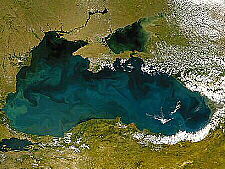 |
| Algea bloom in the Black Sea |
As the ultimate recipient of discharges from the two large European rivers
(Danube and Dnipro) and a large number of smaller rivers, the Black Sea
is very vulnerable to pressure from land-based human activity and its health
is equally dependent on the coastal and non-coastal states of its basin.
The Strategic Action Plan for the Rehabilitation and Protection of the Black
Sea adopts a basin-wide approach to remedial actions and pollution reduction.
The approach is further promoted under the Declaration on Water and Water-Related
Issues in the Wider Black Sea Region and under the Memorandum of Understanding
Between the Commission on the Protection of the Black Sea against Pollution
and the International Commission on the Protection of the Danube River.
The main pressures on the Black Sea ecosystem arise from pollution from
land-based sources, incidental and operation spills from oil vessels and
ports, overfishing and invasion of exotic species. According to the national
reports recently received by the Black Sea Commission, although pollution
pressure from land-based sources is still intense, it shows obvious signs
of a downward trend both in the municipal and industrial sectors. Progress
has been reported in terms of pollution reduction from 49 high priority
pollution sources, discharges of insufficiently treated waters and air emissions
in all Black Sea coastal states.
The available scientific and monitoring data on the concentrations of nutrients
in marine water, which have been recognized as the main cause of eutrophication
in the Black Sea and the most severe environmental pressure on its ecosystem,
provide clear evidence of the overall reduction of nutrients in the marine
environment during the last decade. The observed trends reported by national
sources were further supported by the data from the NATO project for the
open sea that studied areas not covered by the national studies.
Overall decreasing trends are currently reported for oil-related pollution
in marine waters of all Black Sea coastal states. Only in the harbor of
Constanta and near the petrochemical plant in Romania are pollution levels
higher. In the Russian Federation, oil-related pollution does not exceed
the national water quality standards and was below detection limits in 1999.
Decreasing trends are also reported for Turkish and Ukrainian coastal waters.
Polyaromatic hydrocarbons constitute a critical part of oil pollution having
proven carcinogenic and mutagenic effects. Due to their low solubility,
their concentrations in marine water are not monitored. In bottom sediments,
the highest levels were detected near Odesa, the Danube coastline and in
Sochi, the Russian Federation.
The levels and trends of radionuclide pollution do not pose a threat to
human health and biota. Since the Chernobyl accident, radioactivity has
gradually been decreasing and has currently almost reached the previous
values although, in general, the background values in the Black Sea are
twice as high as those in the Mediterranean. Persistent organic contaminants,
mostly polychlorinated byphenils and organochlorine pesticides, do not seem
to be a problem for marine waters. The Russian Federation excluded this
substance from its national monitoring programme due to low concentrations
found in marine waters (below detection limits). Lindane and DDT are usually
found in the mouth of the Danube River in spring.
 |
The environment of the Black Sea and its fragile and vulnerable ecosystem,
with their recreational and aesthetic value that benefits the coastal population,
are showing the first signs of recovery: fewer instances of less intense
algal blooms have been reported by all Black Sea coastal states; total fish
catches in the Black Sea are increasing mostly due to the stocks of small
pelagic fish species, and the number of introduced species is continuously
increasing.
Along with the first signs of recovery of the Black Sea ecosystem, the economies
of the Black Sea coastal states in transition have begun to recover, according
to the available macroeconomic indicators. The envisaged accession of Bulgaria,
Romania and Turkey to the European Union and the related need for those
countries to comply with strict European legislation is also contributing
to the health of the Black Sea environment.
These optimistic signals should not hinder the pursuit of existing problems.
The Black Sea is still a sea in trouble: algae blooms are still heavy and
pollution - although localized - affects the biological communities. The
restoration of Zernov’s Field will take a long time and the outcome
is uncertain. Fish stocks of commercially valuable species, such as sturgeons
and turbots, suffer from illegal fishing and from pollution and destruction
of their habitats. The process of recovery of the Black Sea will take a
long time and will require the implementation of all measures envisaged
by the Black Sea Strategic Action Plan as well as some future provisions.
The process will be further complicated by the fact that scientific knowledge
and information on many processes and phenomena, which are needed for policy
and decision making, are missing.
A comprehensive scientific assessment of the state of the Black Sea environment
is provisioned in the GEF Ecosystem Recovery Project, 2002-2004. Supplemented
by the data from national monitoring programmes, this assessment will form
a basis for the State of the Environment of the Black Sea Report in 2006.
The cooperative efforts of the coastal and non-coastal states in the Black
Sea Basin are seen as a guarantee that the Black Sea ecosystem will be sustained
and rehabilitated and that the strategic and intermediate targets developed
jointly by the Black Sea Commission and the ICPDR will be achieved.